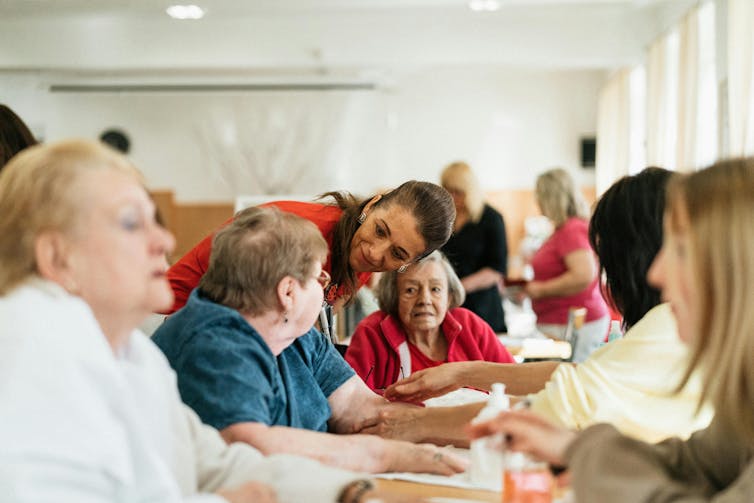- Home
Edition
Africa Australia Brasil Canada Canada (français) España Europe France Global Indonesia New Zealand United Kingdom United States Edition:
Global
Edition:
Global
- Africa
- Australia
- Brasil
- Canada
- Canada (français)
- España
- Europe
- France
- Indonesia
- New Zealand
- United Kingdom
- United States
 Academic rigour, journalistic flair
Academic rigour, journalistic flair
 Care recipients (and sometimes staff) wear a tag or wristband with a sensor that communicates with beacons placed throughout the walls and ceilings of the building.
(Unsplash+/Getty Images)
Tracking with care: The ethics of using location tracking technology with people living with dementia
Published: November 27, 2025 7.28pm GMT
Madalena Pamela Liougas, University of Toronto, Alisa Grigorovich, Brock University
Care recipients (and sometimes staff) wear a tag or wristband with a sensor that communicates with beacons placed throughout the walls and ceilings of the building.
(Unsplash+/Getty Images)
Tracking with care: The ethics of using location tracking technology with people living with dementia
Published: November 27, 2025 7.28pm GMT
Madalena Pamela Liougas, University of Toronto, Alisa Grigorovich, Brock University
Authors
-
 Madalena Pamela Liougas
Madalena Pamela Liougas
PhD Candidate, Rehabilitation Science Institute, University of Toronto
-
 Alisa Grigorovich
Alisa Grigorovich
Associate professor, Department of Recreation and Leisure Studies, Brock University
Disclosure statement
Alisa Grigorovich receives funding from AMS Healthcare (Fellowship in Compassion and Artificial Intelligence) and SSHRC.
Madalena Pamela Liougas does not work for, consult, own shares in or receive funding from any company or organisation that would benefit from this article, and has disclosed no relevant affiliations beyond their academic appointment.
Partners
University of Toronto provides funding as a founding partner of The Conversation CA.
Brock University and University of Toronto provide funding as members of The Conversation CA-FR.
Brock University provides funding as a member of The Conversation CA.
View all partners
DOI
https://doi.org/10.64628/AAM.gqxa6j55t
https://theconversation.com/tracking-with-care-the-ethics-of-using-location-tracking-technology-with-people-living-with-dementia-268459 https://theconversation.com/tracking-with-care-the-ethics-of-using-location-tracking-technology-with-people-living-with-dementia-268459 Link copied Share articleShare article
Copy link Email Bluesky Facebook WhatsApp Messenger LinkedIn X (Twitter)Print article
Imagine you’re 83 years old, living with dementia in a long-term care home. Lately, your caregivers keep asking you to wear a bracelet on your wrist 24/7. They say it’s for your safety, so they can locate you quickly when needed.
At first, you think it’s OK, and it looks like a watch, so you go along. But you soon notice it never comes off. You must wear it everywhere, even in private spaces like your bed and bathroom. This becomes annoying, especially when you realize that it doesn’t have any functions that are useful to you.
What you may be unaware of is that it also collects information about your daily movements.
This technology is a real-time location system (RTLS), and it’s becoming increasingly common in hospitals and long-term care homes. They are promoted as improving physical safety and quality of care and are used for nurse calls, contact tracing, preventing unaccompanied exits and more.
Research demonstrating RTLS’s worth is sparse, and its use raises questions around data security, privacy and control. This is the case for those most affected by RTLS — older adults, family caregivers and direct care staff — whose perspectives are often overlooked in technology research.
 Care staff in a study said it was often simpler to locate residents in person.
(Pexels/Jsme Mila)
Care staff in a study said it was often simpler to locate residents in person.
(Pexels/Jsme Mila)
Real-time location systems
An RTLS works like an indoor GPS. Residents under care at a long-term care home (and sometimes staff) wear a tag or a bracelet with a sensor that communicates with beacons placed throughout the walls and ceilings of the building. The system enables the tracking of people wearing the sensor in real time, and collects movement data. It can also send automated geo-fencing alerts, such as when someone enters or exits a room.
Interest in RTLS in long-term care and other health-care settings largely stems from the belief that they can be useful for predicting changes in health and well-being if clinical algorithms could be developed to analyze movement data.
As part of a larger project, our research team conducted a study with residents, family caregivers, direct care staff and administrators in one home that purchased an RTLS. Administrators and family caregivers told us that RTLS could make care safer and more efficient by increasing staff’s ability to continuously monitor residents and enable quicker intervention.
However, staff informed us that it was often simpler to locate residents in person, and that they lacked time and resources for continuous remote monitoring of residents or to investigate and respond in real time.
This reinforced our findings from an earlier study of this technology in a hospital setting that similarly suggested that RTLS may increase staff workload. More concerningly, we found that administrators, staff and caregivers had limited awareness of this technology’s ethical implications, including its impact on residents, and lacked the knowledge and skills to involve residents in decision-making.
Power and control
In the setting we studied, consent for the use of RTLS came from substitute decision-makers — often a family caregiver — as most residents of the home lived with severe cognitive impairment or dementia. Many caregivers consented quickly, believing RTLS would help staff stay aware of residents’ whereabouts, without fully considering residents’ preferences. Few family caregivers involved residents in the consent process, despite their legal obligation as their substitute decision-makers to align decisions with residents’ values.
While most residents agreed to wear the bracelet, some explicitly rejected the idea of sharing their location data with family or staff. Over time, many wearers found no direct value in it and frequently described it as uncomfortable and heavy.
 Some were unsure how to explain RTLS’s benefits and risks or respond to residents’ concerns.
(Unsplash+/Getty Images)
Some were unsure how to explain RTLS’s benefits and risks or respond to residents’ concerns.
(Unsplash+/Getty Images)
Caregivers didn’t fully know what data was collected by RTLS, who owned the data or how it would be used to improve care beyond localization. Still, most believed that having more information about residents’ movements was beneficial and morally justified the continuous surveillance.
Although privacy rights are protected by law in Canada and the United States, many family caregivers told the researchers they believed residents gave up those rights by entering long-term care. Some also sought access to RTLS data collected about their family members, expecting it would be shared to enhance transparency, although this never happened.
Staff faced their own challenges. Some were unsure how to explain RTLS’s benefits and risks to residents and to their families or respond to residents’ concerns. They lacked guidance on whether to respect a resident’s refusal to wear the tracking bracelet or override it based on family consent.
This left staff uncertain about how to balance residents’ autonomy with their duty of care, and contributed to moral distress among employees.
Future considerations
Our research suggests RTLS offers uncertain benefits and creates new challenges in an already under-resourced sector. Its use also raises ethical concerns, particularly around surveillance and control, which can exacerbate power imbalances and perpetuate digital ageism and digital ableism.
Digital ageism refers to discrimination on the basis of age that intersects with digital economies. Examples include limited or stereotypical representation of old age or older people in data training sets, tech design that doesn’t reflect the heterogeneity of older users, the push to replace humans with technologies in caring for older adults and automated algorithmic decision-making that discriminates against older adults.
Decision-making around RTLS needs to fully involve those who will be affected by these technologies. Before deciding to wear a tracking bracelet, residents and families should be supported in discussing this with care staff who help them to understand and reflect on:
- What information will this technology collect?
- Who will see it?
- How will it be used in practice to improve my care?
- Are these improvements worth compromising my privacy?
This is ethical decision-making: transparent, collaborative and grounded in dignity.
- Privacy
- Dementia
- Nursing home
- Data privacy
- Caregiving
- Tracking
- Informed consent
- Long-term care
Events
Jobs
-
 Senior Lecturer, Human Computer Interaction
Senior Lecturer, Human Computer Interaction
-
University Lecturer in Early Childhood Education
-
 Case Specialist, Student Information and Regulatory Reporting
Case Specialist, Student Information and Regulatory Reporting
-
 Lecturer in Paramedicine
Lecturer in Paramedicine
-
 Associate Lecturer, Social Work
Associate Lecturer, Social Work
- Editorial Policies
- Community standards
- Republishing guidelines
- Analytics
- Our feeds
- Get newsletter
- Who we are
- Our charter
- Our team
- Partners and funders
- Resource for media
- Contact us
-
-
-
-
Copyright © 2010–2025, The Conversation
 Senior Lecturer, Human Computer Interaction
Senior Lecturer, Human Computer Interaction
 Case Specialist, Student Information and Regulatory Reporting
Case Specialist, Student Information and Regulatory Reporting
 Lecturer in Paramedicine
Lecturer in Paramedicine
 Associate Lecturer, Social Work
Associate Lecturer, Social Work